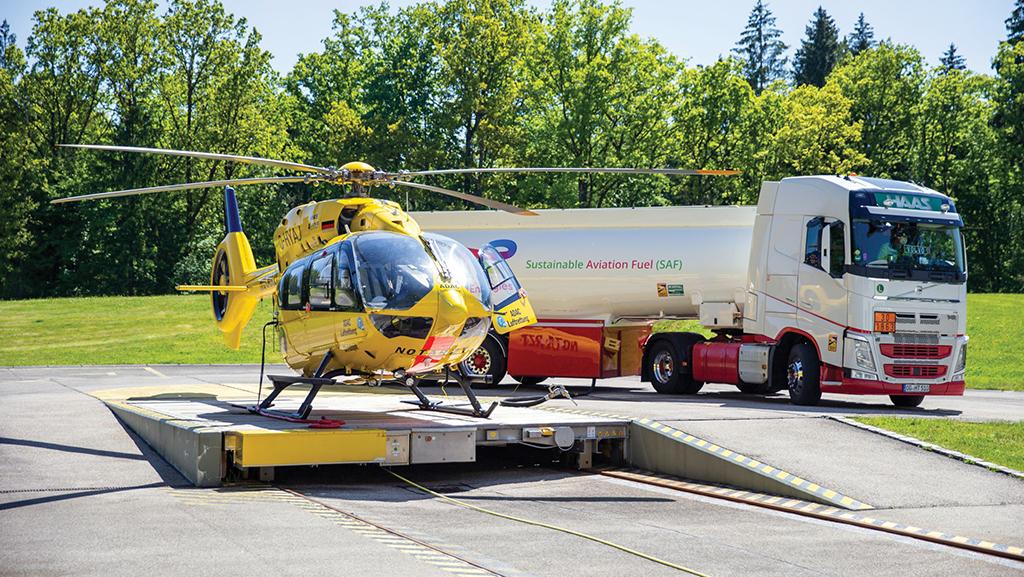

The rotorcraft industry and operators have begun taking the first steps toward using sustainable aviation fuels in a bid to meet global emissions targets.
While helicopter operations may not be under the decarbonization spotlight that much of the commercial airline industry is, in part because of the role they play in keeping society safe through law-enforcement, air ambulance and search-and-rescue activities, helicopter operators are beginning to face government and regulatory pressure to meet emission targets. Contracts—particularly in the oil and gas industry—are increasingly requiring low-emission operations from applicants.
- Safran/ADAC agreement targets 100% SAF use in 2023
- Bell is flying its training academy fleet on 30% SAF blend
The rotorcraft industry is setting out to better understand whether sustainable aviation fuels (SAF) can help put a dent in the carbon footprint of rotary-wing operators.
In a call to the wider rotorcraft industry, Airbus has established a SAF User Group, which aims to tackle the challenges around biofuels and accelerate their use.
The creation of the user group came just days after Safran announced June 7 it had begun working in conjunction with German emergency medical service operator ADAC Luftrettung (Air Rescue) to perform the first air rescue flight in Europe using SAF developed from processed cooking oil, produced by France’s TotalEnergies.
Bell, too, has adapted SAF for use on the company’s 20 U.S.-based training helicopters. They will use a blend of 30% SAF and 70% Jet-A1. Bell is using Neste MY SAF supplied by Avfuel Corp.
“In aviation we have to make a transformation, and it will be the case for the helicopter as well,” Bruno Bellanger, vice president for programs at Safran Helicopter Engines, tells Aviation Week.
The June 7 debut flight, using an Airbus H145 twin-engine light helicopter—powered by a pair of Safran Arriel engines—is part of a trial with ADAC beginning this summer. The goal will be to transition from an initial blend of 40% SAF and traditional Jet-A1 aviation fuel to the sole use of SAF on Safran-powered rotorcraft.
All Safran’s helicopter engines are certified to operate with a SAF blend of 50%, but the engine OEM wants to rapidly transition to 100% SAF use and achieve a technology readiness level of 6 by 2023.
With such a wide range of SAFs becoming available, and the likelihood that some may not have the same characteristics as Jet-A1, the company is assessing whether the engines need to be adapted or modified to cope with the fuels.
This includes looking at components such as seals and pumps and how they behave with the different fuels as well as exploring additives that might need to be used to change the fuel’s characteristics.
According to ADAC, if its fleet of more than 50 helicopters were powered by a 40% blend of SAF, as on the June 7 flight, it could reduce its CO2 emissions by 33%. With sole use of SAF, Safran suggests ADAC could cut emissions 80%.
It comes at a steeper price, however. Every gallon of Total-Energies SAF costs four times that of conventional fuel—for now. “[This is a] chicken-and-egg question,” Bellanger says. “Should demand for SAF increase, we will be in a position to reduce the price very quickly.”
As well as cutting emissions, the benefits of SAF may also include reduced coking in the engines, leading to reduced maintenance cost and lower smoke emissions.
For Safran, the focus is primarily on so-called second-generation SAF, fuels that use waste materials and have no impact on agricultural food production. However, the company is also eyeing the potential of e-fuels, also known as power-to-liquid (PTL) synthetic fuels, which are produced using electricity from renewable sources such as solar or wind. The process, similar to the electrolysis process used for the extraction of hydrogen, generates fuel from water and CO2 extracted from the air.
“Like existing fuels, PTLs are a drop-in solution, so there will not be a strong impact on infrastructure or on the fuel system and on the engine,” Bellanger says. “But much depends on the ability to produce sustainable electricity.”
Bellanger says SAF and PTL fuels could be the primary source of fuel for helicopters in the future, given the energy density and weight challenges associated with hydrogen, fuel cells and battery power for conventional rotorcraft compared with fixed-wing aircraft.
